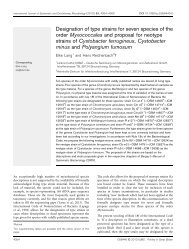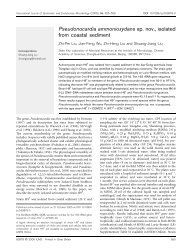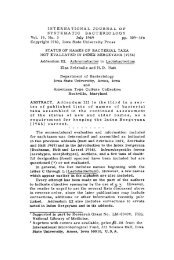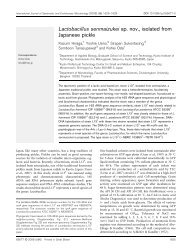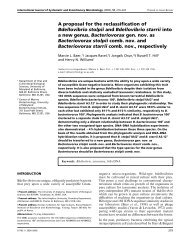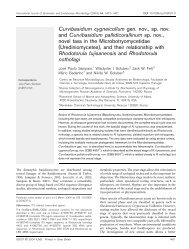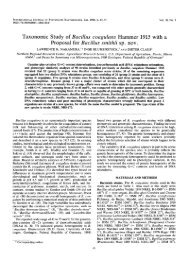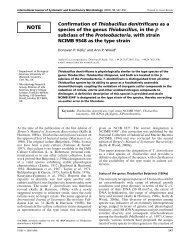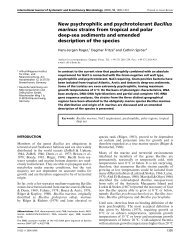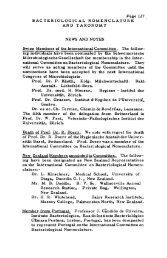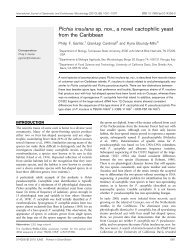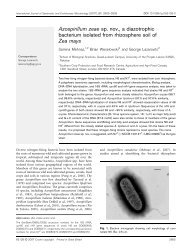Auriculibuller fuscus gen. nov., sp. nov. and Bullera japonica sp. nov ...
Auriculibuller fuscus gen. nov., sp. nov. and Bullera japonica sp. nov ...
Auriculibuller fuscus gen. nov., sp. nov. and Bullera japonica sp. nov ...
You also want an ePaper? Increase the reach of your titles
YUMPU automatically turns print PDFs into web optimized ePapers that Google loves.
International Journal of Systematic <strong>and</strong> Evolutionary Microbiology (2004), 54, 987–993 DOI 10.1099/ijs.0.02970-0<br />
Corre<strong>sp</strong>ondence<br />
José Paulo Sampaio<br />
jss@fct.unl.pt<br />
INTRODUCTION<br />
The phenotypic circumscription of the basidiomycetous<br />
anamorphic <strong>gen</strong>us <strong>Bullera</strong> Derx is based on the production<br />
of rotationally symmetrical ballistoconidia, absence of<br />
bud-forming stalks, white to cream or yellowish cultures,<br />
inositol assimilation, production of starch-like compounds<br />
(a few exceptions are known for the two latter tests),<br />
CoQ10 as the major ubiquinone system <strong>and</strong> the presence<br />
of xylose in whole-cell hydrolysates (Boekhout & Nakase,<br />
1998). Presently, the <strong>gen</strong>us <strong>Bullera</strong> comprises approximately<br />
30 <strong>sp</strong>ecies that belong to the Tremellales, based on<br />
various molecular phylo<strong>gen</strong>etic analyses (Fell et al., 2000;<br />
Nakase, 2000; Bai et al., 2001; Scorzetti et al., 2002). Until<br />
now, two teleomorphic <strong>gen</strong>era, Bulleromyces Boekhout<br />
<strong>and</strong> Fonseca (Boekhout et al., 1991) <strong>and</strong> Bulleribasidium<br />
Sampaio, Weiss <strong>and</strong> Bauer (Sampaio et al., 2002) have had<br />
Abbreviations: ITS, internal transcribed <strong>sp</strong>acer; MCMC, Markov chain<br />
Monte Carlo.<br />
The GenBank/EMBL/DDBJ accession numbers for the sequences<br />
determined in this study are shown in Table 1.<br />
<strong>Auriculibuller</strong> <strong>fuscus</strong> <strong>gen</strong>. <strong>nov</strong>., <strong>sp</strong>. <strong>nov</strong>. <strong>and</strong><br />
<strong>Bullera</strong> <strong>japonica</strong> <strong>sp</strong>. <strong>nov</strong>., <strong>nov</strong>el taxa in the<br />
Tremellales<br />
José Paulo Sampaio, 1 João Inácio, 1 Álvaro Fonseca, 1 Mário Gadanho, 1<br />
Isabel Spencer-Martins, 1 Gloria Scorzetti 2 <strong>and</strong> Jack W. Fell 2<br />
1 Centro de Recursos Microbiológicos, Secção Autónoma de Biotecnologia, Faculdade de<br />
Ciências e Tecnologia, Universidade Nova de Lisboa, 2829-516 Caparica, Portugal<br />
2 Rosenstiel School of Marine <strong>and</strong> Atmo<strong>sp</strong>heric Science, University of Miami,<br />
4600 Rickenbacker Causeway, Key Biscayne, FL 33419, USA<br />
Seven phylloplane yeast strains that were collected in the Arrábida Natural Park, Portugal, <strong>and</strong><br />
identified preliminarily as <strong>Bullera</strong> alba, the anamorphic stage of Bulleromyces albus, were<br />
investigated. In contrast to Bulleromyces albus, these isolates produced a brownish pigment<br />
when grown on potato dextrose agar. The pigment caused darkening of the cultures <strong>and</strong> diffused<br />
into the culture medium. Mating studies revealed that the Arrábida isolates did not react with<br />
the different mating types of Bulleromyces albus, but were sexually compatible with them <strong>and</strong><br />
produced mycelium with clamp connections, haustoria <strong>and</strong> transversally septate basidia that<br />
ejected the basidio<strong>sp</strong>ores. Various taxonomic criteria that were evaluated during the present<br />
study <strong>and</strong> comparison with other sexual taxa of the Tremellales indicated that this teleomorph<br />
should be classified in a <strong>nov</strong>el <strong>gen</strong>us. Therefore, <strong>Auriculibuller</strong> <strong>fuscus</strong> <strong>gen</strong>. <strong>nov</strong>., <strong>sp</strong>. <strong>nov</strong>.<br />
(type strain, PYCC 5690 T =CBS 9648 T ) is proposed. In addition, during the course of this<br />
investigation, a member of a <strong>nov</strong>el <strong>Bullera</strong> <strong>sp</strong>ecies, <strong>Bullera</strong> <strong>japonica</strong> <strong>sp</strong>. <strong>nov</strong>. (type strain, PYCC<br />
4534 T =CBS 2013 T ), was found among collection isolates that were identified formerly as<br />
<strong>Bullera</strong> alba. In molecular phylo<strong>gen</strong>etic analysis of the D1/D2 domains of the 26S rDNA <strong>and</strong><br />
the internal transcribed <strong>sp</strong>acer region, the two taxa were found to be closely related, but<br />
distinct at the <strong>sp</strong>ecies level.<br />
their anamorphic counterparts in <strong>Bullera</strong>. However, no<br />
teleomorph is known for most <strong>Bullera</strong> <strong>sp</strong>ecies. Implementation<br />
of molecular phylo<strong>gen</strong>etic analyses based on DNA<br />
sequence data has emphasized the need to integrate mito<strong>sp</strong>oric<br />
taxa, such as <strong>Bullera</strong>, into the classification system<br />
that was originally built exclusively for sexual fungi.<br />
Ballistoconidia-producing yeasts are found frequently in<br />
the phylloplane. Forceful liberation of propagules seems<br />
to constitute an ecological advantage for colonization <strong>and</strong><br />
dissemination in the plant leaf environment (Nakase,<br />
2000). A 2 year survey (1997–1998) of the phylloplane<br />
yeast communities that are found on selected plants from<br />
two study sites in the Arrábida Natural Park, Portugal,<br />
was carried out by Inácio et al. (2002). This natural park<br />
encompasses different microclimatic areas with <strong>sp</strong>ecific<br />
formations of typically Mediterranean vegetation. Among<br />
a vast majority of isolates of basidiomycetous affinity,<br />
seven yeast strains were identified preliminarily as <strong>Bullera</strong><br />
alba Hanna, the anamorphic stage of Bulleromyces albus<br />
Boekhout <strong>and</strong> Á. Fonseca. In contrast to Bulleromyces<br />
albus, these isolates produced a brownish pigment when<br />
02970 G 2004 IUMS Printed in Great Britain 987
J. P. Sampaio <strong>and</strong> others<br />
grown on potato dextrose agar. The pigment caused<br />
darkening of the cultures <strong>and</strong> diffused into the culture<br />
medium. Subsequent mating studies revealed that the new<br />
isolates did not react with the different mating types of<br />
Bulleromyces albus, but were sexually compatible with each<br />
other <strong>and</strong> produced clamped mycelium with haustoria,<br />
basidia <strong>and</strong> basidio<strong>sp</strong>ores in culture. Several taxonomic<br />
criteria that have been evaluated during the present study<br />
indicate that these Arrábida isolates should be accommodated<br />
in a <strong>nov</strong>el <strong>gen</strong>us, rather than in any existing<br />
<strong>gen</strong>us of the Tremellales. Moreover, during the course of<br />
this investigation, a <strong>nov</strong>el <strong>Bullera</strong> <strong>sp</strong>ecies was found<br />
among collection isolates that were identified previously<br />
as <strong>Bullera</strong> alba.<br />
METHODS<br />
Two methods were used for isolation: one was based on the plating<br />
of leaf washings, as described by Inácio et al. (2002), <strong>and</strong> the other<br />
on the <strong>sp</strong>ore-fall method. Leaves were collected from different plants<br />
(see Table 1) in the Arrábida Natural Park [for further details, see<br />
Inácio et al. (2002)]. A list of cultures of the <strong>nov</strong>el taxa described in<br />
this study is shown in Table 1. For microscopy, cultures were grown<br />
on MYP agar [malt extract, 0?7 % (w/v); yeast extract, 0?05 % (w/v);<br />
soytone peptone, 0?25 % (w/v); <strong>and</strong> agar, 1?5 % (w/v)] at room<br />
temperature (20–23 uC) <strong>and</strong> examined with an Olympus BX50<br />
microscope by using phase-contrast optics. For determination of<br />
sexual compatibility, pairs of 2–4-day-old cultures were mixed on<br />
MYP agar, incubated at room temperature <strong>and</strong> examined for<br />
production of mycelium <strong>and</strong> clamp connections after 2 weeks.<br />
Physiological <strong>and</strong> biochemical characterization followed the methods<br />
described by Yarrow (1998). Additional assimilation tests were performed<br />
by using aldaric acids <strong>and</strong> aromatic compounds as described<br />
by Fonseca (1992) <strong>and</strong> Sampaio (1999), re<strong>sp</strong>ectively.<br />
For determination of the extent of DNA relatedness, total <strong>gen</strong>omic<br />
DNA was extracted <strong>and</strong> purified by using the procedures described<br />
by Sampaio et al. (2001). For DNA–DNA reassociation experiments,<br />
a Gilford Re<strong>sp</strong>onse UV-VIS <strong>sp</strong>ectrophotometer <strong>and</strong> its thermal<br />
programming software were used <strong>and</strong> the methods of Kurtzman<br />
et al. (1980) were followed.<br />
DNA sequence analysis, DNA extraction, PCR amplification, purification<br />
<strong>and</strong> cycle sequencing followed the protocol of Fell et al. (2000).<br />
Alignments were made with MegAlign (DNAStar) <strong>and</strong> corrected<br />
visually. To estimate phylo<strong>gen</strong>etic relationships, we applied the<br />
Bayesian Markov chain Monte Carlo (MCMC) method of phylo<strong>gen</strong>etic<br />
inference (Larget & Simon, 1999), as implemented in the<br />
computer program MRBAYES (Huelsenbeck & Ronquist, 2001). This<br />
method allows estimation of the a posteriori probability that groups<br />
of taxa are monophyletic, given the DNA alignment (i.e. the probability<br />
that corre<strong>sp</strong>onding bipartitions of the <strong>sp</strong>ecies set are present in<br />
the true unrooted tree, including the given <strong>sp</strong>ecies). Four incrementally<br />
heated simultaneous Monte Carlo Markov chains were run over<br />
1 000 000 <strong>gen</strong>erations by using the <strong>gen</strong>eral time-reversible model of<br />
DNA substitution with C-distributed substitution rates (GTR+G),<br />
r<strong>and</strong>om starting trees <strong>and</strong> default starting parameters of the DNA<br />
substitution model. Trees were sampled every 100 <strong>gen</strong>erations,<br />
resulting in an overall sampling of 10 000 trees. From those trees<br />
that were sampled after the process had reached a stationary stage, a<br />
consensus tree was computed to obtain estimates for a posteriori<br />
probabilities. This Bayesian approach to phylo<strong>gen</strong>etic analysis was<br />
repeated several times, always using r<strong>and</strong>om starting trees <strong>and</strong><br />
default starting values for the model parameters to test the reproducibility<br />
of the results.<br />
RESULTS AND DISCUSSION<br />
Latin diagnosis of <strong>Auriculibuller</strong> Sampaio et<br />
Fonseca <strong>gen</strong>. <strong>nov</strong>.<br />
Fungus dimorphus. Basidiomata nulla. Basidia plerumque<br />
transversalitre, interdum longitudinalitre septata, fibulata, in<br />
fasciculis parvis an binatim di<strong>sp</strong>osita. Basidio<strong>sp</strong>orae globosae,<br />
a sterigmatibus eiciuntur, gemmis vel repetitione germinant.<br />
Hyphae hyalinae, fibulatae, haustoriis tremelloideis. Status<br />
anamorphosium in <strong>gen</strong>us <strong>Bullera</strong>m pertinet. Typus <strong>gen</strong>eris:<br />
<strong>Auriculibuller</strong> <strong>fuscus</strong> in opere ipso descriptus.<br />
Table 1. Source, sexuality <strong>and</strong> GenBank accession numbers of cultures of the <strong>nov</strong>el taxa described in this study<br />
Species* Isolation source SexualityD GenBank no.<br />
D1/D2 ITS<br />
<strong>Auriculibuller</strong> <strong>fuscus</strong>:<br />
PYCC 5690 T =A2AVS4 T<br />
Acer mon<strong>sp</strong>essulanum, Arrábida, Portugal MT A1 AF444762 AF444668<br />
PYCC 5691=A2AVS5 Acer mon<strong>sp</strong>essulanum, Arrábida, Portugal MT A2 AF444763 AF444669<br />
PYCC 5739=A2QVSI1 Quercus faginea, Arrábida, Portugal MT A2 AF444764 AF444670<br />
PYCC 5740=A1CVV1 Cistus albidus, Arrábida, Portugal MT A2 AF444761 AF444667<br />
A2AVS6 Acer mon<strong>sp</strong>essulanum Arrábida, Portugal MT A1<br />
2AVF3 Acer mon<strong>sp</strong>essulanum, Arrábida, Portugal MT A2<br />
A5QSV2 Quercus faginea, Arrábida, Portugal MT A2<br />
<strong>Bullera</strong> <strong>japonica</strong> PYCC 4534 T =CBS 2013 T<br />
Zelkowa <strong>sp</strong>., Japan ANA AF444760 AF444666<br />
*CBS, Centraalbureau voor Schimmelcultures, Yeast Division, Utrecht, the Netherl<strong>and</strong>s; PYCC, Portuguese Yeast Culture Collection, FCT-UNL,<br />
Portugal.<br />
DANA, Anamorphic; MT, mating type.<br />
988 International Journal of Systematic <strong>and</strong> Evolutionary Microbiology 54
Description of <strong>Auriculibuller</strong> Sampaio <strong>and</strong><br />
Fonseca <strong>gen</strong>. <strong>nov</strong>.<br />
<strong>Auriculibuller</strong> (Au.ri.cu.li.bul9ler. L. fem. n. auricula earlobe,<br />
referring to the auricularioid nature of the basidia;<br />
N.L. n. <strong>Bullera</strong> referring to the anamorphic yeast <strong>gen</strong>us<br />
<strong>Bullera</strong>; N.L. masc. n. <strong>Auriculibuller</strong> auricularioid yeast that<br />
is similar to the <strong>gen</strong>us <strong>Bullera</strong>).<br />
Dimorphic. Basidiocarps are absent. Basidia are typically<br />
transversally septate or occasionally longitudinally septate,<br />
arranged in small clusters or in pairs <strong>and</strong> clamped. Basidio<strong>sp</strong>ores<br />
are globose, rotationally symmetrical, produced at<br />
the apex of tubular sterigmata <strong>and</strong> forcibly discharged;<br />
germination occurs by budding or repetition. Hyphae are<br />
hyaline <strong>and</strong> clamped with tremelloid haustoria. Anamorphic<br />
stage produces ballistoconidia <strong>and</strong> budding yeast cells<br />
<strong>and</strong> is classified in the <strong>gen</strong>us <strong>Bullera</strong>. The type <strong>sp</strong>ecies is<br />
<strong>Auriculibuller</strong> <strong>fuscus</strong>.<br />
Latin diagnosis of <strong>Auriculibuller</strong> <strong>fuscus</strong><br />
Sampaio, Inácio, Fonseca et Fell <strong>sp</strong>. <strong>nov</strong>.<br />
Cultura in striis post septem dies cremea, fuscans aetate<br />
progrediente. Post unum mensem cultura fusca, mucilaginea,<br />
superficie laevi, nitida. In statu unicellulari cellulae ovoideae,<br />
(3) 4–565–8 mm. Sterigmata 1–267–30 mm, interdum<br />
usque ad 60 mm longa. Ballistoconidia globosa (4–5?5 mm)<br />
ad subglobosa (4?5–566–7 mm). Mycelium hyphis fibulatis,<br />
1?5–2 mm diametro, haustoriis tremelloideis. Basidia cylindracea,<br />
transversalitre septata, bicellulata. Basidio<strong>sp</strong>orae globosae<br />
ad subglobosae, 5–7 mm diametro, parietibus tenuibus,<br />
eiciuntur a sterigmatibus (1–268–15 mm), gemmis vel<br />
repetitione germinant. Characteres biochemici physiologicique<br />
<strong>Auriculibuller</strong>i fusci in tabula 2 describuntur.<br />
Description of <strong>Auriculibuller</strong> <strong>fuscus</strong> Sampaio,<br />
Inácio, Fonseca <strong>and</strong> Fell <strong>sp</strong>. <strong>nov</strong>.<br />
<strong>Auriculibuller</strong> <strong>fuscus</strong> (fus9cus. L. masc. adj. <strong>fuscus</strong> darkcoloured,<br />
referring to the greyish-brown darkening of the<br />
cultures that occurs upon ageing).<br />
Streak culture after 1 week is cream-coloured; becomes<br />
darker upon ageing. After 1 month, cultures are greyishbrown,<br />
mucilaginous, smooth-surfaced <strong>and</strong> glossy. Yeast<br />
cells are ovoid after 4 days on MYP agar, measuring (3)<br />
4–565–8 mm. Sterigmata are 1–267–30 mm or occasionally<br />
up to 60 mm in length. Ballistoconidia are globose<br />
(4–5?5 mm) to subglobose (4?5–566–7 mm) (Fig. 1).<br />
Hyphae are 1?5–2 mm in diameter with clamp connections<br />
<strong>and</strong> haustoria, which are formed after crossing of sexually<br />
compatible strains (Fig. 2). Haustorial cells are globose<br />
to slightly elongated (Fig. 2). Basidia initials are at first<br />
globose <strong>and</strong> then become cylindrical (Fig. 3); they are<br />
arranged in small clusters or isolated (Fig. 3). Mature<br />
basidia are two-celled, normally transversally septate <strong>and</strong><br />
cylindrical, measuring 5–7620–30 mm. Basidio<strong>sp</strong>ores are<br />
globose to slightly subglobose (5–7 mm in diameter), thinwalled,<br />
ejected from sterigmata that measure 1–268–15 mm<br />
Two <strong>nov</strong>el taxa in the Tremellales<br />
Fig. 1. Line drawings of yeast cells (Y), ballistoconidio<strong>gen</strong>ic<br />
cells <strong>and</strong> ballistoconidia (B indicates released ballistoconidia) of<br />
<strong>Auriculibuller</strong> <strong>fuscus</strong> (PYCC 5690 T <strong>and</strong> PYCC 5739) observed<br />
on MYP agar after 4–7 days. Bar, 10 mm.<br />
<strong>and</strong> germinate by budding or repetition (Fig. 3). Biochemical<br />
<strong>and</strong> physiological properties of A. <strong>fuscus</strong> are given in<br />
Table 2 <strong>and</strong> its phylo<strong>gen</strong>etic placement is shown in Fig. 5.<br />
The type strain is PYCC 5690 T =CBS 9648 T . A complementary<br />
mating reference strain is PYCC 5739=CBS 9650.<br />
The seven cultures of A. <strong>fuscus</strong> that are listed in Table 1<br />
were isolated in 1997 <strong>and</strong> 1998 from leaves of different<br />
Mediterranean trees <strong>and</strong> shrubs that were collected at the<br />
Fig. 2. Line drawings of the sexual stage of <strong>Auriculibuller</strong><br />
<strong>fuscus</strong> (PYCC 5690 T 6PYCC 5739) observed on MYP agar<br />
after 10–15 days. Yeast cells with appressoria-like structures<br />
(upper left part), conjugation <strong>and</strong> early stages of mycelium formation<br />
(upper right part) <strong>and</strong> hyphae with clamp connections<br />
<strong>and</strong> haustoria (lower part). Bar, 10 mm.<br />
http://ijs.sgmjournals.org 989
J. P. Sampaio <strong>and</strong> others<br />
Fig. 3. Line drawings of the basidial stage of <strong>Auriculibuller</strong><br />
<strong>fuscus</strong> (PYCC 5690 T 6PYCC 5691) <strong>and</strong> comparison with<br />
Bulleromyces albus. (a) Basidia of A. <strong>fuscus</strong> in different developmental<br />
stages: non-septate globose, non-septate cylindrical,<br />
septate <strong>and</strong> septate with sterigmata; note one basidio<strong>sp</strong>ore<br />
between the two sterigmata on the lower right part. (b) Basidia<br />
of Bulleromyces albus (PYCC 45396PYCC 4560); note the<br />
different basidial shape <strong>and</strong> type of septation <strong>and</strong> the sessile<br />
mode of basidio<strong>sp</strong>ore formation. Bar, 10 mm.<br />
Arrábida Natural Park, Portugal. All cultures were isolated<br />
by using the <strong>sp</strong>ore-fall method, except for strain 2AVF3,<br />
which was isolated by using the leaf-washing method.<br />
Sexual compatibility <strong>and</strong> identical microsatellite-primed<br />
PCR fingerprints with primer M13 supported con<strong>sp</strong>ecificity<br />
of those isolates (data not shown). Sexual compatibility<br />
seems to be biallelic, as crossing experiments suggest the<br />
presence of two mating types.<br />
A. <strong>fuscus</strong> is able to complete its life cycle on culture media.<br />
When sexually compatible strains are mixed on MYP agar,<br />
Table 2. Physiological <strong>and</strong> biochemical characteristics of<br />
<strong>Auriculibuller</strong> <strong>fuscus</strong> <strong>and</strong> <strong>Bullera</strong> <strong>japonica</strong><br />
Taxa: 1, <strong>Auriculibuller</strong> <strong>fuscus</strong>; 2, <strong>Bullera</strong> <strong>japonica</strong>. Characteristics<br />
are scored as: +, growth; 2, no growth; D, delayed growth;<br />
V, variable growth. Both taxa were positive for assimilation of<br />
the carbon compounds D-glucose, D-galactose, D-glucosamine,<br />
D-ribose, D-xylose, L-arabinose, D-arabinose, L-rhamnose, sucrose,<br />
maltose, a,a-trehalose, methyl a-D-glucoside, cellobiose, salicin,<br />
melibiose, lactose, raffinose, melezitose, soluble starch, erythritol,<br />
ribitol, xylitol, D-glucitol, D-mannitol, inositol, glucono-d-lactone,<br />
D-gluconic acid, D-glucuronic acid, succinic acid, citric acid, Lmalic<br />
acid, saccharic acid, mucic acid <strong>and</strong> gallic acid <strong>and</strong> the<br />
nitro<strong>gen</strong> compounds ethylamine, L-lysine <strong>and</strong> cadaverine. Both<br />
taxa were positive for growth with 0?01 % cycloheximide, growth<br />
at 25 uC, formation of starch-like compounds, <strong>sp</strong>litting of arbutin,<br />
hydrolysis of urea <strong>and</strong> the diazonium blue B reaction. Both taxa<br />
were negative for fermentation of D-glucose, assimilation of the<br />
carbon compounds inulin, D-tartaric acid, methanol, ethanol,<br />
vanillic acid, ferulic acid, veratric acid, p-hydroxybenzoic acid, mhydroxybenzoic<br />
acid, protocatechuic acid, catechol, salicylic acid,<br />
<strong>gen</strong>tisic acid <strong>and</strong> phenol <strong>and</strong> the nitro<strong>gen</strong> compounds potassium<br />
nitrate, sodium nitrite, creatine <strong>and</strong> creatinine. Both taxa were<br />
negative for growth in vitamin-free medium, growth with 0?1%<br />
cycloheximide <strong>and</strong> growth at 35 uC (these data are available in<br />
tabular form at http://www.crem.fct.unl.pt/dimorphic_basidiomycetes/<br />
Databases/databases.htm).<br />
Characteristic 1 2<br />
Carbon compounds:<br />
L-Sorbose 2 D<br />
Glycerol V D<br />
Galactitol V +<br />
DL-Lactic acid V +<br />
L-Tartaric acid V +<br />
D-Tartaric acid V +<br />
Growth at 30 uC V +<br />
cells with appressorium-like structures develop (Fig. 2).<br />
Conjugation between two cells is difficult to observe,<br />
due to the twisting <strong>and</strong> ramifications of the conjugating<br />
hyphae (Fig. 2). One-week-old crossings show con<strong>sp</strong>icuous<br />
clamped mycelium with haustoria that are able to attach<br />
to hyphae of deuteromycetous culture contaminants,<br />
which suggests that A. <strong>fuscus</strong> is capable of mycoparasitism<br />
in nature. Basidia initials are formed after 6–8 weeks at<br />
room temperature. Transfer of agar blocks of this age to<br />
2 % water agar stimulated basidial formation. Mature<br />
basidia (septated, with sterigmata <strong>and</strong> basidio<strong>sp</strong>ores)<br />
could be detected approximately 1 week after transfer to<br />
water agar.<br />
Latin diagnosis of <strong>Bullera</strong> <strong>japonica</strong> Sampaio,<br />
Fonseca et Fell <strong>sp</strong>. <strong>nov</strong>.<br />
Cultura in striis post septem dies cremea, fuscans aetate<br />
progrediente. Post unum mensem cultura fusca, mucilaginea,<br />
superficie laevi, nitida. Cellulae ovoideae ad cylindraceae,<br />
990 International Journal of Systematic <strong>and</strong> Evolutionary Microbiology 54
(1?5) 2–365–10 (12) mm. Sterigmata 1–268–16 mm.<br />
Ballistoconidia globosa (5–6 mm diametro) ad subglobosa<br />
(4–565–6 mm). Characteres biochemici physiologicique<br />
<strong>Bullera</strong>e <strong>japonica</strong>e in tabula 2 describuntur.<br />
Description of <strong>Bullera</strong> <strong>japonica</strong> Sampaio,<br />
Fonseca <strong>and</strong> Fell <strong>sp</strong>. <strong>nov</strong>.<br />
<strong>Bullera</strong> <strong>japonica</strong> [ ja.po9ni.ca. N.L. adj. <strong>japonica</strong> referring to<br />
the origin (Japan) of the single culture of this <strong>sp</strong>ecies that<br />
is presently known].<br />
Streak culture after 1 week is cream-coloured; becomes<br />
darker upon ageing. After 1 month, cultures are greyishbrown,<br />
mucilaginous, smooth-surfaced <strong>and</strong> glossy. Yeast<br />
cells are ovoid to cylindrical after 4 days on MYP agar,<br />
measuring (1?5) 2–365–10 (12) mm. Sterigmata are<br />
1–268–16 mm; ballistoconidia are globose (5–6 mm) to<br />
subglobose (4–565–6 mm) (Fig. 4). Biochemical <strong>and</strong><br />
physiological properties of <strong>Bullera</strong> <strong>japonica</strong> are presented<br />
in Table 2 <strong>and</strong> its phylo<strong>gen</strong>etic placement is shown in<br />
Fig. 5.<br />
The type strain of <strong>Bullera</strong> <strong>japonica</strong> (PYCC 4534 T =CBS<br />
2013 T ) was isolated by K. Tubaki in Japan from Zelkowa <strong>sp</strong>.<br />
The phylo<strong>gen</strong>etic placement of A. <strong>fuscus</strong> <strong>and</strong> <strong>Bullera</strong><br />
<strong>japonica</strong> was inferred by using the D1/D2 domains of<br />
the 26S rDNA <strong>and</strong> the Bayesian MCMC method of phylo<strong>gen</strong>etic<br />
inference (Fig. 5). As expected, both taxa belong<br />
to the Tremellales. Sequence data indicated that the two<br />
<strong>nov</strong>el taxa described in this report are related most closely<br />
to one another. Their D1/D2 sequences differed by three<br />
nucleotide substitutions <strong>and</strong> one single-base indel. The<br />
four strains of A. <strong>fuscus</strong> that were sequenced (see Table 1)<br />
have identical sequences; therefore, only the sequence of<br />
the type strain was used in molecular analyses. In the<br />
analysis shown in Fig. 5, the pair A. <strong>fuscus</strong>–<strong>Bullera</strong> <strong>japonica</strong><br />
has, as its closest teleomorphic relative, Papiliotrema<br />
b<strong>and</strong>onii Sampaio, Gadanho, Weiss <strong>and</strong> Bauer. Both<br />
<strong>Auriculibuller</strong> <strong>and</strong> Papiliotrema have auricularioid basidia.<br />
In order to study in more detail the relationship between<br />
Fig. 4. Line drawings of yeast cells (Y), ballistoconidio<strong>gen</strong>ic<br />
cells <strong>and</strong> ballistoconidia (B indicates released ballistoconidia) of<br />
<strong>Bullera</strong> <strong>japonica</strong> (PYCC 4534 T ) observed on MYP agar after<br />
4–7 days. Bar, 10 mm.<br />
Two <strong>nov</strong>el taxa in the Tremellales<br />
A. <strong>fuscus</strong> <strong>and</strong> <strong>Bullera</strong> <strong>japonica</strong>, the complete internal<br />
transcribed <strong>sp</strong>acer (ITS) region (ITS1+5?8S rDNA+<br />
ITS2) of the two taxa was investigated (the phylo<strong>gen</strong>etic<br />
tree is available at http://www.crem.fct.unl.pt/dimorphic_<br />
basidiomycetes/Databases/databases.htm). Again, the four<br />
strains of A. <strong>fuscus</strong> showed identical sequences that differed<br />
from that of <strong>Bullera</strong> <strong>japonica</strong> by seven substitutions <strong>and</strong><br />
one single-base indel. In ITS analysis, P. b<strong>and</strong>onii was the<br />
closest relative of A. <strong>fuscus</strong> <strong>and</strong> <strong>Bullera</strong> <strong>japonica</strong>. Nuclear<br />
DNA–DNA reassociation experiments between two strains<br />
of A. <strong>fuscus</strong> (PYCC 5690 T <strong>and</strong> PYCC 5739) yielded high<br />
relatedness values (92–93 %), whereas each of these strains<br />
produced intermediate values in reassociation experiments<br />
with <strong>Bullera</strong> <strong>japonica</strong> (52–58 % relatedness). Moreover,<br />
crossings of <strong>Bullera</strong> <strong>japonica</strong> with the two mating types<br />
of A. <strong>fuscus</strong> invariably gave negative results. Physiological<br />
<strong>and</strong> biochemical characterization of the two <strong>nov</strong>el taxa,<br />
presented in Table 2, showed that, except for the assimilation<br />
of L-sorbose, A. <strong>fuscus</strong> <strong>and</strong> <strong>Bullera</strong> <strong>japonica</strong> are<br />
indistinguishable. As indicated in Table 2, a few tests gave<br />
variable results for A. <strong>fuscus</strong>.<br />
The two <strong>nov</strong>el taxa share a peculiar cultural characteristic:<br />
when grown on potato dextrose agar, they produce a<br />
brownish pigment that darkens the cultures <strong>and</strong> diffuses<br />
into the agar. This trait is absent in Bulleromyces albus<br />
<strong>and</strong> motivated a deeper analysis of the pigment-producing<br />
isolates.<br />
The <strong>gen</strong>us <strong>Auriculibuller</strong>, described in the present report,<br />
is the third <strong>gen</strong>us to accommodate the sexual stages of<br />
the mito<strong>sp</strong>oric ballistoconidial <strong>gen</strong>us <strong>Bullera</strong>. The other<br />
two <strong>gen</strong>era are Bulleromyces <strong>and</strong> the recently described<br />
<strong>gen</strong>us Bulleribasidium (Sampaio et al., 2002). De<strong>sp</strong>ite<br />
similar basidial morphologies, <strong>Auriculibuller</strong> <strong>and</strong> Bulleribasidium<br />
are clearly distinct, based on the molecular<br />
phylo<strong>gen</strong>etic hypothesis presented in Fig. 5. From an evolutionary<br />
point of view, <strong>Auriculibuller</strong> <strong>and</strong> Bulleromyces<br />
seem to share a recent common ancestor. The phylo<strong>gen</strong>etic<br />
placement of these two <strong>gen</strong>era correlates with the morphological<br />
comparison that is also presented in Fig. 5. Whereas<br />
A. <strong>fuscus</strong>, P. b<strong>and</strong>onii <strong>and</strong> Tremella exigua Desm. have<br />
clavate to cylindrical basidia with obliquely to transverse<br />
septa, Bulleromyces albus <strong>and</strong> three Tremella <strong>sp</strong>ecies of<br />
the Indecorata group sensu Chen 1998, namely Tremella<br />
indecorata Sommerf. Fr., Tremella moriformis (Fr.) Smith<br />
ex Berk. <strong>and</strong> Tremella nivalis C.-J. Chen, have subglobose<br />
to pyriform, longitudinally or obliquely cruciate–septate<br />
basidia. In Fig. 5, the clade for which basidial types<br />
are presented contains two well-supported monophyletic<br />
groups. One includes the <strong>sp</strong>ecies with a tremelloid basidial<br />
plan <strong>and</strong> the other includes <strong>Auriculibuller</strong> <strong>and</strong> Papiliotrema,<br />
which have clavate basidia with obliquely to transverse<br />
septation. This topology was also observed in maximumparsimony<br />
analysis (data not shown), but the bootstrap<br />
values were <strong>gen</strong>erally lower that the a posteriori probability<br />
values of MCMC analyses. As can be observed in the<br />
illustrations that are included in Fig. 5, T. exigua shows<br />
http://ijs.sgmjournals.org 991
J. P. Sampaio <strong>and</strong> others<br />
Fig. 5. Phylo<strong>gen</strong>etic tree of <strong>Auriculibuller</strong> <strong>fuscus</strong>, <strong>Bullera</strong> <strong>japonica</strong> <strong>and</strong> related taxa of the Tremellales, inferred by using<br />
Bayesian MCMC analysis of an alignment of the D1/D2 region of 26S rDNA. Numbers on branches are estimates for a<br />
posteriori probabilities, i.e. probabilities that the re<strong>sp</strong>ective groups are monophyletic given the alignment. The topology was<br />
rooted with Filobasidium floriforme, Filobasidium uniguttulatum <strong>and</strong> Filobasidium capsuli<strong>gen</strong>um. Names in bold type<br />
corre<strong>sp</strong>ond to organisms discussed in the comparison of basidial types <strong>and</strong>/or to <strong>nov</strong>el taxa described in this report. GenBank<br />
accession numbers of sequences are indicated after strain numbers. Schematic illustrations of basidial types are inserted for<br />
<strong>Auriculibuller</strong>, Bulleromyces, Papiliotrema [redrawn from Sampaio et al. (2002)] <strong>and</strong> selected Tremella <strong>sp</strong>ecies [redrawn from<br />
Chen (1998); the basidial types of Tremella moriformis <strong>and</strong> Tremella indecorata are basically similar to that of Tremella nivalis<br />
<strong>and</strong> are not shown].<br />
992 International Journal of Systematic <strong>and</strong> Evolutionary Microbiology 54
an intermediate basidial morphology. In the various<br />
MCMC analyses that were carried out during this study,<br />
the position of this <strong>sp</strong>ecies was found to vary <strong>and</strong> never<br />
received high statistical support. In the ITS tree (see<br />
Supplementary Figure, available at http://www.crem.fct.unl.<br />
pt/dimorphic_basidiomycetes/Databases/databases.htm),<br />
<strong>sp</strong>ecies with Tremella-type basidia were again well-separated<br />
from <strong>Auriculibuller</strong> <strong>and</strong> Papiliotrema, the latter being placed<br />
in the vicinity of the <strong>nov</strong>el <strong>gen</strong>us that is described in this<br />
report. The possible con<strong>sp</strong>ecificity between A. <strong>fuscus</strong> <strong>and</strong><br />
<strong>Bullera</strong> <strong>japonica</strong>, which is suggested by pigment production,<br />
nutritional similarity <strong>and</strong> D1/D2 sequence data, was ruled<br />
out, based on greater sequence diver<strong>gen</strong>ce of ITS data,<br />
absence of sexual compatibility <strong>and</strong> lack of high DNA–<br />
DNA reassociation values.<br />
The unravelling of <strong>nov</strong>el sexual taxa <strong>and</strong> mito<strong>sp</strong>oric<br />
<strong>sp</strong>ecies, such as those described here, is essential to<br />
exp<strong>and</strong> our assessment of the diversity of the Tremellales<br />
<strong>and</strong> allied taxa of the Tremellomycetidae. Accumulation<br />
of more data on the Tremellales by means of multidisciplinary<br />
approaches will set the basis for a more<br />
accurate per<strong>sp</strong>ective on the evolutionary history of these<br />
organisms <strong>and</strong> will consequently contribute to improved<br />
classification proposals. Another issue in the systematics<br />
of the Tremellales is the <strong>gen</strong>us concept for this group. The<br />
polyphyletic nature of Tremella, as depicted in Fig. 5,<br />
suggests that the tremelloid basidial type, the key character<br />
for the <strong>gen</strong>us, needs to be combined with other markers<br />
for adequate <strong>gen</strong>eric differentiation. Molecular studies<br />
have also indicated that asexual <strong>gen</strong>era, such as <strong>Bullera</strong><br />
<strong>and</strong> Cryptococcus Vuillemin, are polyphyletic (Fell et al.,<br />
2000). On the other h<strong>and</strong>, the same approaches have<br />
validated the <strong>gen</strong>eric concept of Fibulobasidium B<strong>and</strong>oni<br />
<strong>and</strong> fostered the segregation of <strong>sp</strong>ecies from hetero<strong>gen</strong>eous<br />
assemblages into natural groups, such as Dioszegia Zsolt<br />
emend. Takashima, Deak <strong>and</strong> Nakase (Takashima et al.,<br />
2001). The proposal of <strong>Auriculibuller</strong> in this report follows<br />
this trend.<br />
ACKNOWLEDGEMENTS<br />
J. I. <strong>and</strong> M. G. were supported by grants PRAXIS/XXI/BD/19833 <strong>and</strong><br />
SFRH/BD/1170/2000, re<strong>sp</strong>ectively, <strong>and</strong> J. W. F. was supported by the<br />
USA National Science Foundation, Division of Environmental Biology<br />
(DEB 0206521). We thank Michael Weiß (University of Tübin<strong>gen</strong>,<br />
Germany) for preparing the Latin diagnoses <strong>and</strong> for advice concerning<br />
the MCMC phylo<strong>gen</strong>etic analyses.<br />
REFERENCES<br />
Bai, F.-Y., Takashima, M. & Nakase, T. (2001). Phylo<strong>gen</strong>etic analysis<br />
of strains originally assigned to <strong>Bullera</strong> variabilis: descriptions of <strong>Bullera</strong><br />
pseudohuiaensis <strong>sp</strong>. <strong>nov</strong>., <strong>Bullera</strong> komagatae <strong>sp</strong>. <strong>nov</strong>. <strong>and</strong> <strong>Bullera</strong><br />
pseudoschimicola <strong>sp</strong>. <strong>nov</strong>. Int J Syst Evol Microbiol 51, 2177–2187.<br />
Two <strong>nov</strong>el taxa in the Tremellales<br />
Boekhout, T. & Nakase, T. (1998). <strong>Bullera</strong> Derx. In The Yeasts, a<br />
Taxonomic Study, 4th edn, pp. 731–741. Edited by C. P. Kurtzman &<br />
J. W. Fell. Amsterdam: Elsevier.<br />
Boekhout, T., Fonseca, A. & Batenburg-van der Vegte, W. H.<br />
(1991). Bulleromyces <strong>gen</strong>us <strong>nov</strong>um (Tremellales), a teleomorph for<br />
<strong>Bullera</strong> alba, <strong>and</strong> the occurrence of mating in <strong>Bullera</strong> variabilis.<br />
Antonie van Leeuwenhoek 59, 81–93.<br />
Chen, C.-J. (1998). Morphological <strong>and</strong> molecular studies in the<br />
<strong>gen</strong>us Tremella. Bibl Mycol 174, 1–225.<br />
Fell, J. W., Boekhout, T., Fonseca, A., Scorzetti, G. & Statzell-<br />
Tallman, A. (2000). Biodiversity <strong>and</strong> systematics of basidiomycetous<br />
yeasts as determined by large-subunit rDNA D1/D2 domain<br />
sequence analysis. Int J Syst Evol Microbiol 50, 1351–1371.<br />
Fonseca, A. (1992). Utilization of tartaric acid <strong>and</strong> related<br />
compounds by yeasts: taxonomic implications. Can J Microbiol 38,<br />
1242–1251.<br />
Huelsenbeck, J. P. & Ronquist, F. (2001). MRBAYES: Bayesian<br />
inference of phylo<strong>gen</strong>etic trees. Bioinformatics 17, 754–755.<br />
Inácio, J., Pereira, P., Carvalho, M., Fonseca, Á., Amaral-Collaço,<br />
M. T. & Spencer-Martins, I. (2002). Estimation <strong>and</strong> diversity of<br />
phylloplane mycobiota on selected plants in a Mediterranean-type<br />
ecosystem in Portugal. Microbial Ecol 44, 344–353.<br />
Kurtzman, C. P., Smiley, M. J., Johnson, C. J., Wickerham, L. J. &<br />
Fuson, G. B. (1980). Two new <strong>and</strong> closely related heterothallic<br />
<strong>sp</strong>ecies, Pichia amylophila <strong>and</strong> Pichia mississippiensis: characterization<br />
by hybridization <strong>and</strong> deoxyribonucleic acid reassociation. Int J Syst<br />
Bacteriol 30, 208–216.<br />
Larget, B. & Simon, D. L. (1999). Markov chain Monte Carlo<br />
algorithms for the Bayesian analysis of phylo<strong>gen</strong>etic trees. Mol Biol<br />
Evol 16, 750–759.<br />
Nakase, T. (2000). Exp<strong>and</strong>ing world of ballisto<strong>sp</strong>orous yeasts:<br />
distribution in the phyllo<strong>sp</strong>here, systematics <strong>and</strong> phylo<strong>gen</strong>y. J Gen<br />
Appl Microbiol 46, 189–216.<br />
Sampaio, J. P. (1999). Utilization of low molecular weight aromatic<br />
compounds by heterobasidiomycetous yeasts: taxonomic implications.<br />
Can J Microbiol 45, 491–512.<br />
Sampaio, J. P., Gadanho, M., Santos, S., Duarte, F. L., Pais, C.,<br />
Fonseca, Á. & Fell, J. W. (2001). Polyphasic taxonomy of the<br />
basidiomycetous yeast <strong>gen</strong>us Rhodo<strong>sp</strong>oridium: Rhodo<strong>sp</strong>oridium<br />
kratochvilovae <strong>and</strong> related anamorphic <strong>sp</strong>ecies. Int J Syst Evol<br />
Microbiol 51, 687–697.<br />
Sampaio, J. P., Weiß, M., Gadanho, M. & Bauer, R. (2002). New<br />
taxa in the Tremellales: Bulleribasidium oberjochense <strong>gen</strong>. et <strong>sp</strong>.<br />
<strong>nov</strong>., Papiliotrema b<strong>and</strong>onii <strong>gen</strong>. et <strong>sp</strong>. <strong>nov</strong>. <strong>and</strong> Fibulobasidium<br />
murrhardtense <strong>sp</strong>. <strong>nov</strong>. Mycologia 94, 873–887.<br />
Scorzetti, G., Fell, J. W., Fonseca, A. & Statzell-Tallman, A.<br />
(2002). Systematics of basidiomycetous yeasts: a comparison of<br />
large subunit D1/D2 <strong>and</strong> internal transcribed <strong>sp</strong>acer rDNA regions.<br />
FEMS Yeast Res 2, 495–517.<br />
Takashima, M., Deak, T. & Nakase, T. (2001). Emendation of<br />
Dioszegia with redescription of Dioszegia hungarica <strong>and</strong> two new<br />
combinations, Dioszegia aurantiaca <strong>and</strong> Dioszegia crocea. J Gen Appl<br />
Microbiol 47, 75–84.<br />
Yarrow, D. (1998). Methods for the isolation, maintenance <strong>and</strong><br />
identification of yeasts. In The Yeasts, a Taxonomic Study, 4th edn,<br />
pp. 77–100. Edited by C. P. Kurtzman & J. W. Fell. Amsterdam:<br />
Elsevier.<br />
http://ijs.sgmjournals.org 993



